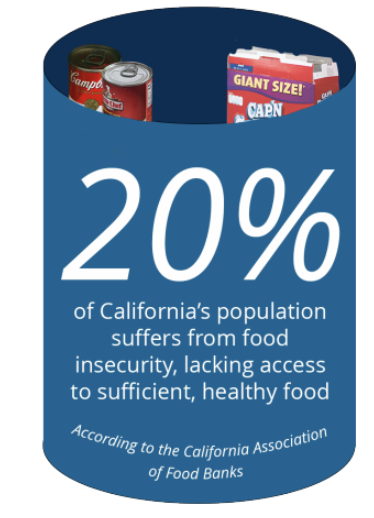Inflation exacerbates the Bay Area’s hunger crisis

Graphic illustrations by Nicole Ge and Amishi Chandra
As California experiences the highest inflation in nearly four decades, soaring prices in the Bay Area have made food less affordable, increasing pressure on food banks.
February 6, 2023
As California experiences the highest inflation in nearly four decades, soaring prices in the Bay Area have made food less affordable, increasing pressure on food banks. Rising food prices has led to a decrease in food banks’ donations and volunteers, rendering food banks unable to meet the demand for food.
The COVID-19 pandemic led to a disruption in the global supply chain and a rapid economic collapse. Although the economy grew back after the Federal Reserve conducted an easy monetary policy to increase its interest rate from 0% to 0.25%, customers’ demand for products expanded and prices rose. Over the last year, food became 10.6% more expensive, grocery prices rose 12% and restaurant menu prices increased by 8.5%. This sharp increase in food prices has made food inaccessible to many people struggling with poverty. According to the U.S. Department of Agriculture, 1.3 billion people could not access sufficient amounts of nutritious food in 2022.
“Food insecurity and global hunger is a crisis stretching back more than 50 years,” said Graham Riches, Emeritus Social Work Professor at the University of British Columbia. “The demand for wasted food has stayed unremitting.”
More people rely on food banks or pantries to meet their minimum nutritional requirements as they face higher costs. Silicon Valley Food Bank, one of the largest food banks in the Bay Area, reported a 1.7 million pound decrease in donated food compared to 2021. The number of people they distributed food to increased from 400,000 people in a year to 450,000 people each month.
According to the California Association of Food Banks, California produces half of the nation’s fruits and vegetables; yet, one in five Californians currently struggle with food insecurity. Hunger in the U.S. is mainly caused by poverty, the lack of a job or having a job that pays too little. The national economy is directly related to hunger as COVID-19 had a severe impact on employment and income, leading to many people not being able to afford food.
This crisis has also been largely driven by climate change. Extreme weather drives hunger as global temperatures and sea levels rise, and heat waves, droughts, wildfires and other natural disasters become more apparent. The increasing frequency of weather abnormalities make it harder for farmers to produce food at sufficient levels.
Due to societal inequalities, greater levels of hunger are experienced by Black, Latin and multiracial Californians. Conversely, California’s white and Asian populations experience lower rates of food insecurity.
With efforts to solve the U.S.’s current hunger crisis, the Biden administration’s plan includes implementing benefits like free school meals and food stamps, hoping to end the crisis by 2030. There are also many programs and nonprofits that raise money and collect food to help starving people. The Supplemental Nutrition Assistance Program is the largest food and nutrition program in the U.S., specifically helping low-income Americans. The U.S. Department of Agriculture buys food from farmers, delivering it to food banks to distribute among their community.
However, without effective income support, increasing food prices have burdened both local food banks and people in need. Recognizing their difficulties, communities have contributed to food banks in various ways, especially as unpaid volunteers.
“I found volunteering at food banks an accessible way to help my community,” CSF activity coordinator Aarya Aluri said. “It helps people much more than expected.”




























































